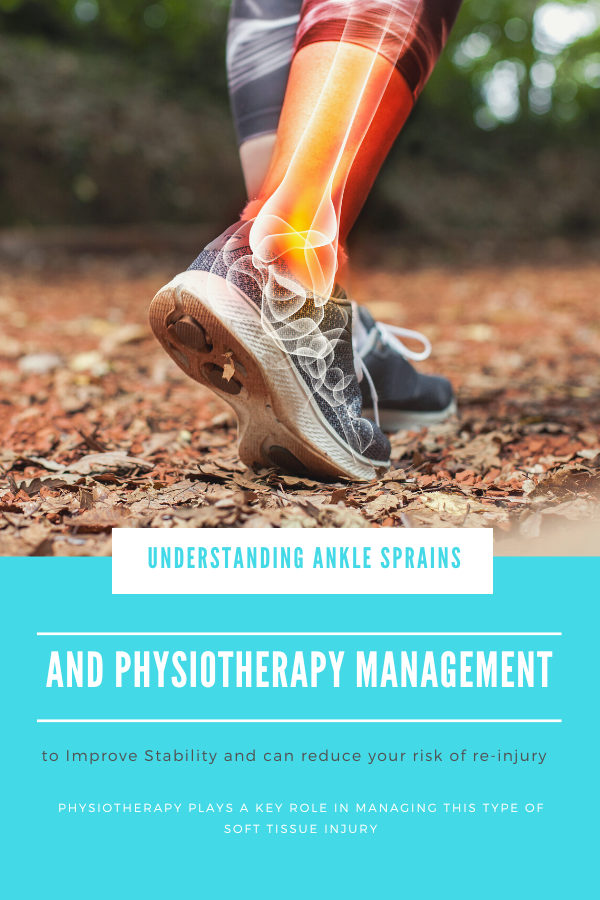Did you know that ankle sprain is one of the most common injuries?
Understanding Ankle Sprains and Physiotherapy Management to Improve Stability and long-term results
Ankles are complex, weight-bearing joints that are critical for balance and mobility. They are made up of many bones, ligaments, muscles and tendons that work together to provide stability. When these components become weakened or damaged, it can cause an ankle sprain—an injury that is not only painful but can also be debilitating if not treated properly. In this blog post, I will look at the risk factors for ankle sprains, how they are classified, and the evidence-based treatment goals to help improve stability and long term results.
The ankle is a complex joint made up of three bones, the tibia, fibula and talus. It is a weight bearing joint, absorbs shock from running and jumping activities, and helps us move in multiple directions.
It is also prone to injury, especially in those who run, jump or those who are at risk of falls. A common injury that occurs at the ankle is an ankle sprain.
Risk Factors for Ankle Sprains
The most common risk factor for ankle sprains is taking part in activities that involve jumping or running such as basketball or football. Running on uneven ground (such as trails) may also increase your chances of getting an ankle sprain. People who have previous ankle injuries, muscle weakness or poor flexibility may also be more prone to suffering from an ankle sprain.
Sprain Grades
Ankle sprains are graded by the direction of force applied on the ankle at the time of injury ie if you rolled your ankle inwards or outwards.
The sprains are put into 3 Grades based on the severity
grade I (mild) - involves minimum stretching of the ligaments and you might feel some tenderness but no instability
grade II (moderate)- involves partial tearing with moderate joint instability and slight pain
grade III (severe)- results in complete rupture of a ligament causing significant instability, pain and swelling
Physiotherapy for ankle sprains
The main goals of physiotherapy treatment is to;
Depending on the sprain grading, treatment may include rest, ice/cold therapy, compression, taping or brace support
Reduce pain and swelling
Exercises to improve joint mobility, muscle strength, proprioception and balance in the ankle
Physiotherapy is an important role in recovery by helping to restore the ankle joint range of motion and strength, and to improve balance and proprioception (the ability to sense where one’s body is in space). According to The British Journal of Sports Medicine, it suggested these types of exercises should continue for at least 6 months following injury as optimal outcomes have been found when people continued to manage their sprain over this time period also, neuromuscular (relating to the nerves that control muscles) training programs using balance boards have been shown to decrease recurrence rates by up to 50%. Other physio interventions may include treatments such as ultrasound therapy or dry needling to help reduce pain while you're still in the rehab process.
Try these simple but effective ankle drills
PAILS: Progressive Ankle Isometric Lengthening Stretches; This will help your ankle to lengthen and become more flexible over time.
RAILS: Regressed Ankle Isometric Lengthening Stretches; This will help to gradually increase the ROM (range of motion) in the ankle joint.
CARS: Controlled Articular Rotations; This involves rotating your ankle joint in circles as you move through your full range.
Doing these drills regularly will increase your mobility & flexibility in the ankle joint making it strong for your next running adventure and helps reduce your risk of (re) injury. So, what are you waiting for?
⬇️⬇️ Start unlocking your ankle TODAY with my physio guided tutorial ⬇️⬇️
Ankle sprains can be debilitating injuries if not treated properly. Physiotherapy plays a key role in managing this type of soft tissue injury; evidence-based treatments such as strengthening exercises aimed at improving stability around the joint combined with helping to reduce pain, improve joint mobility and can reduce your risk of re-injury significantly.
So, If you think you have sustained an ankle sprain or your ankle pain doesn't seem to be getting any better – book a physio appointment with me today!


